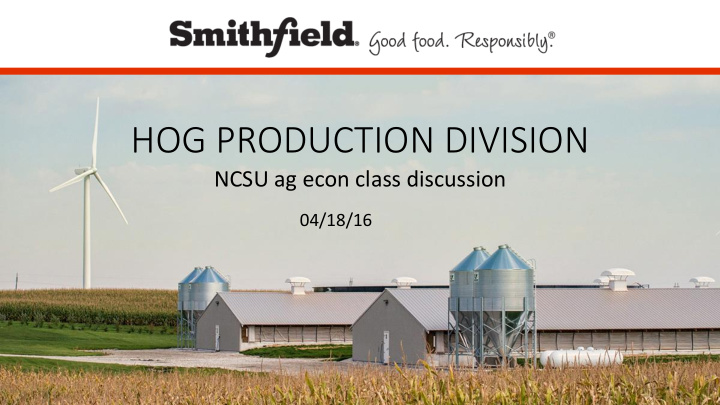



HOG PRODUCTION DIVISION NCSU ag econ class discussion 04/18/16
2 Today’s Topics • Who are we? • Intro to Smithfield • Market news – Corn, Wheat, and Soybeans • Life as a grain originator for Smithfield Grain • Differentiating from the competition • Intern program
3 Jo Josh Goode who are we? • Grain Origination Manger – Southern Region & Ohio • Kansas State – undergrad (Ag Business) • Worked with Smithfield for 3 years (Interned with MBgrain in 2014 summer cohort) • Bagged 3M bushels in Laurinburg during 2014 internship • Live in Wilmington, NC • Moved from Kansas to North Carolina
4 Taylor Cowan who are we? • Grain Originator • Northeast Region • Elevators in Hobbsville and Elizabeth City, NC • Feed mill in Creswell, NC • NCSU - undergrad (Ag Business Management & Economics) • Graduated Spring 2017 • Took this class two years ago • Live in Williamston, NC
5 Intro to Smithfield • WH Group (China) purchased Smithfield in 2013. • $15B global food company, headquartered in Smithfield, VA • World’s largest pork processor and hog producer. • 48,000 employees across all divisions. • Vertically integrated business. Genetics, farms, feed manufacturing, processing, packaging, distribution. • 15M hogs produced /year (~50K to market /day).
6 Intro to Smithfield and MBgrain
7 Intro to Smithfield Grain • Based out of Rose Hill, NC. • Responsible for sourcing all ingredients delivered to Smithfield feed mills across the US. • Use ~120M bushels (corn/wheat/milo) /year. • Grain supplied locally and imported (rail or vessel). • Goal is to supply quality grain/ingredients at low cost to keep hog business competitive. • 70% of cost of raising a hog is from grain.
8 Smithfield Grain – where we trade 35 buying stations across the Untied States Based on this information, where would you grow hogs?
9 Smithfield local grain pile in Yuma, Colorado
10 Bagging corn in Nevada, Missouri
11 Grain bags full of corn and wheat in Waverly, Virginia
12 Grain ship unloading at Wilmington port
14 Corn/Wheat/Soybean – US and Local news
15 Corn story
16 Wheat story
17 Soybeans story
19 Grain Originator’s focus and challenges • Responsible for sourcing quality grain to assigned feed mill(s) at the lowest landed basis possible (Futures + Basis = Flat Price). • We’re in the commodity business - hogs eat everyday, regardless of supply/demand (i.e. costs). • Local is most always cheapest grain – but there’s not enough to feed the hogs • Farmer (customer) relationships are key • Intercompany relationships are critical to success
20 Basis Traders – MBgrain.com • Why can a farmer get more $ delivering to feed mill vs. grain elevator? (aka, why is Feed mill basis greater than elevator basis?) • Why do you think Creswell, NC feed mill would be cheaper at harvest than any other feed mill?
21 Freight Matters • Farmer wants to sell 5,000 bushels of old crop corn • His bins are in Raeford, NC He calls the grain originators for both end users to learn: 1. Smithfield bid = 65CK15 2. Perdue bid = 80CK15 42 miles Where should farmer sell his grain? What needs to be considered? 20 miles
22 Freight Matters (cont) 1. Smithfield bid = 65CK15 2. Perdue bid = 80CK15 Where should farmer sell his grain? Smithfield Perdue 42 miles Futures 3.9 3.9 Basis 0.65 0.75 miles 20 45 rate/mile 3.25 3.5 20 miles Bushels 929 929 FOB Price $ 4.48 $ 4.48
23 Life as a grain originator • Early morning • 7:00a – Read morning grain comments while drinking Starbucks expresso (or 2 diet mountain dews) • 7:30a – Review inventories at your feed mill provided daily by mill staff • 8:00a – Review mill position (yesterday’s feed production, incoming grain, what’s left to ship from farmers, upcoming rail, port lineup, freight) • Mid-morning – check in with customers (maintenance on existing grain contracts, recruit new bushels, market intel, inform on market) • Lunch – buy a farmer lunch • Afternoon – scout fields, understand local crop conditions • Evening – paperwork - contracts, put in pricing orders, etc.
24 Differentiating from other end-users • Wheat Seed Program • Non-GMO Soybean Progarm • We want to be the PREFERRED buyer of local grain. • Farmers have choices, and there’s only a limited supply of grain. • How do we maximize our local handle?
25 Differentiating from other end-users • We want to be the PREFERRED buyer of local grain • Farmers have choices, and there’s only a limited supply of grain. • How do we maximize our local handle? 1. Customer Service – from originators, to mill personnel, mill capabilities 2. Marketing Options to fit farmer’s businesses 3. Always have a market 4. Flexible hours at harvest – 24/7 5. Agronomic assistance 6. Quick payment 7. Off the farm pickup program 8. Alternative markets (sorghum, Non-GMO beans) 9. Partner with Universities for research to increase production in Mid-Atlantic Regions
Smithfield Grain Internship 26
Smithfield Internship • 7th year we’ve done program • Ag interest preferred (not required) • People skills important • Willingness to work long hours • Good problem solver 27
Internship Details Our goal = improve customer service J/J wheat Exposure to Middle Projects – Beginning End harvest at most MB work with feed mills areas – management understand what we do 28
What do you get? • MONEY!! • Exposure to large company in Ag industry • Sharpen Communication skills • Decision making skills • Possible college credit • Networking • Possible long-term employment 29
QUESTIONS? 30
Recommend
More recommend